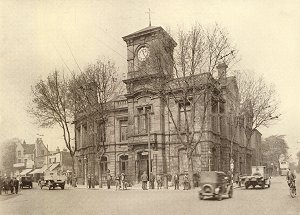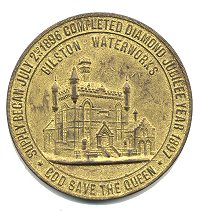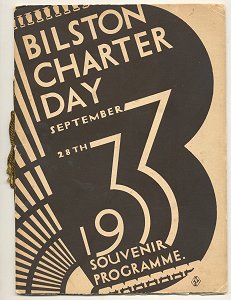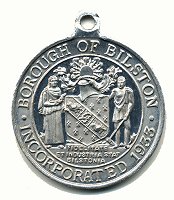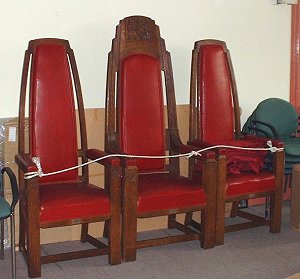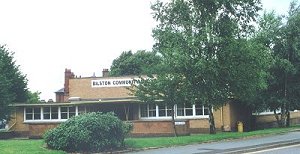FROM CHARTER TO CHIPS Local government in Bilston by Reg Aston Bilston’s first statutory local government authority was The Bilston Township Commissioners and Local Board of Health, which was established in 1850 following the second cholera epidemic of 1849. Its main purpose was to improve the town and township by taking control of paving, lighting, watching, cleansing and sewers. Baths and washhouses were erected in 1853. This was followed in 1855 by an eleven-acre cemetery off the Wellington Road.
Bilston Town Hall was built in 1872 with a Free Library added to the building a year later.
In 1890 a new Post Office was built in Hall Street and within a few years, in 1891, a new Market Hall had been built along with a rebuilt Swimming Baths, a Technical/Art Schools on Mount Pleasant and the Bilston Waterworks at the Bratch, Wombourne. In 1908 a deep sewage scheme was completed with its main works in a corner of the Lunt by the Bilston Brook.
The Commissioners were replaced in 1888 by the Bilston Urban District Council of which Mr S.B.Cole was the inaugural chairman. After being controlled by the U.D.C. for 39 years Bilston was granted a Charter of Incorporation in 1933. This important change of status meant that the new Bilston Borough Council was empowered with a much wider range of responsibilities and amongst other things was able to install its own mayor. The first person to hold the position, as Charter Mayor was Herbert Beach J.P., formerly the Chairman of the previous UDC.
The official handing over of the Charter was performed by the Earl of Harrowby, Lord Lieutenant of Staffordshire, at a special ceremony in the town’s Hickman Park on 28th September 1933. It was attended by council officials, townspeople, schoolchildren, 6th South Staffs Territorials, Scouts, Guides and both Boys & Girls Brigades.
The first council included several prominent businessmen and traders including coal merchant J.Toole, butcher J.E.Downs, Ettingshall fried fish dealer John Roberts, Oxford Street painter J.T.Baker, local film and cinema entrepeneur T.R.Wood and Bradley furniture dealer, Walter M. Hughes.
Over the years Bilston’s councillors took pride in the good and well being of the townspeople and its first considerations were housing and provision of amenities for residents. The council began the building of the new swimming baths in Prouds Lane on 22nd October 1962 opposite the Health Clinic on the corner of Wellington Road and Prouds Lane, that had been completed some years earlier. The council completed its 6,000th council house in February 1964
On 1st April 1966 the new County Borough of Wolverhampton came into existence. The new extended borough consisted of the original County Borough along with the Borough of Bilston, the urban districts of Tettenhall and Wednesfield, parts of the urban districts of Coseley, Sedgley, Darlaston and Willenhall and parts of the parishes of Lower Penn, Wombourne, Wrottesley, Brewood and Essington. Bilston was at that time a borough in its own right and feelings ran high against the proposal with the belief that the town would lose its civic pride and identity. A campaign was launched under the slogan ‘Bilston for the Bilstonians’ which fought the amalgamation with great vigour. There was even a High Court action over the matter. And a local chippie wrapped its fish and chips in paper bearing the slogan: "If Bilston joins Wolverhampton, we've had out chips". But the West Midlands Order 1965 was approved by Parliament on 16th December 1965 to come into effect on 1st April 1966. The Bilston Borough Council held its last meeting in March 1966 and there was a farewell dinner in the Town Hall. The "streets of evil intent" had swallowed up the old town. Rumblings of discontent persisted for several years and even today many people can be found who still regret, even resent, what they see as a takeover – a takeover which they see as resulting in Bilston being largely ignored by a distant town council. |

